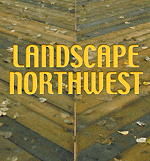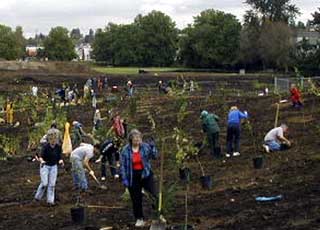
Surveys
DJC.COM
April 19, 2001
Inviting nature back to the neighborhood
EDAW/Anderson & Ray Design Studio

|
Seattle is experiencing an environmental renaissance, reintegrating leftover urban spaces with native landscapes of fact and imagination.
This new urban ecology, applied to once-forgotten and ill-used parcels of land, celebrates that which was, is and could be.
The essence of this renaissance is an appreciation for what a more natural landscape has to offer. Traditionally, we think of parks as tame and formal, carefully planned to the last poppy and brick paver.
Lions and tigers and bears? No way! In other words, no surprises, pleasant or otherwise.
That’s what the new urban ecology is all about — the collision of a tame landscape with one that is wild. In our Palm Pilot navigated world, people crave the solace of less controlled wilderness environments, if only temporarily.
So what are these special places in and around Seattle, and how did they come about?
About five years ago, city agencies such as the Department of Parks and Recreation and the Department of Neighborhoods began to recognize leftover public lands as valuable resources and began a program to identify them for reconstruction and/or restoration.
A group called the Seattle Urban Nature Project is currently surveying existing wildlife habitats and associated wildlife at these sites in order to create maps useful for education, science, conservation, and related purposes.
There are approximately 50 to 60 parcels of this leftover land within the city’s borders, radiating from the urban center in all directions. They range in size from as little as a third of an acre up to 25 acres and in character from featureless open space to municipal equipment storage yards.
A majority of them are located in residential neighborhoods and frequently become dumping grounds. Many of these places are wetlands, have steep slopes or are problematic in some other way.
Applying new urban ecology principles to the question of what to do with these lands reveals solutions as broad and diverse as the regional landscape itself, limited only by one’s imagination.
Improvements to the 12-acre Roxhill Park in West Seattle reestablished the headwaters of Longfellow Creek by recreating a wetland on an exposed ancient peat bog buried for the last 30 years. Working with the Department of Parks and Recreation and community volunteers, EDAW/Anderson & Ray Design Studio developed a new landscape that harks back to the agricultural use of peat. Traditional peat farming plots were based on a grid, as is the Roxhill Park plan.
Integration with the surrounding neighborhood was achieved by knitting the pathways with adjoining streets and walkways. The first phase of the project is nearly complete. When the second phase is finished next year, this urban bog will improve water quality while daylighting the creek.
Most important, it will provide us with an opportunity to observe first-hand the evolution of a unique and delicate ecological system in an urban setting.
Kuwanlalenta is a Hopi word meaning “to make beautiful surroundings.”
For landscape architects and artists, the word is meaningful because it connotes a specific approach to the land. Everything we do is from the perspective of the land itself.
Recreating the native landscape, seeing its evolution as part of the design and letting it evolve is our goal. Unlike the Hopi tradition, it may take a host of scientists, and archaeologists, as well as landscape architects to fully assess the history, character, ecology and potential of each site.
Success also depends on having a local community group that is willing to help design, build and steward a project for years to come.
The fascinating thing about the new urban ecology is that it allows for human intervention and whimsy amidst the canvas of nature.
Pritchard Reserve, on the shores of Lake Washington, is the site of one of the largest wetland restoration efforts in the city of Seattle. This wetland was once a deep slough between a small island in the lake and an urban neighborhood on the shore. The low band of land was exposed when the lake was lowered nine feet in the 1920s.
Working with citizen groups and the Seattle Department of Parks and Recreation, Anderson & Ray replaced 15 acres of abandoned city storage flats and soggy turf with a vibrant lacustrine and scrub shrub and a wetland garden. Central to the project was digging a new pond and connecting it to the lake.
The excavation debris that emerged from the hole was used to create the landform for a “box-of-rocks” amphitheater. Visitors tread lightly on the marshy, wildlife-friendly wetland, thanks to a series of boardwalks and gravel pathways that traverse the landscape.
Another project that celebrates the collision of formal parkland and wilderness is Genesee Meadow. Wedged into a diverse, south Seattle neighborhood, this 25-acre parcel had lain fallow for decades. Originally a slough that was filled with city garbage, the property took the design of a wildflower meadow in 1994.
A sea of lupines and wavy grasses now characterize this unique place, where the Audubon Society monitors bird populations and visitors further their knowledge of native plants, wildlife habitat, and land-use history through an interpretive program.
Recently the project made another evolutionary change with the addition of a third woodland island or mound, thus furthering the concept of perpetual intervention and caretaking for the phased growth that many of these urban ecologies require.
These projects are neither inexpensive nor casual. They can cost hundreds of thousands of dollars and take years to complete. Implementation is made possible by private donations from individuals and various organizations and institutions, the Department of Parks and Recreation and a unique program by Seattle’s Department of Neighborhoods called the Neighborhood Matching Fund.
The fund provides over $3 million each year to Seattle neighborhood groups and organizations for an array of neighborhood-initiated improvements. Once a project is approved, the fund matches in dollars the community’s contribution of volunteer labor, materials, professional services, or cash. Manpower is provided by community volunteers as well as paid contractors for the heavy work.
Leftover urban spaces present an important opportunity to reestablish native wildlife in the city. They transport us back to a much simpler time, perhaps to the days of our youth when the thrill of discovery made us fearless and wide-eyed explorers of our surroundings. That’s ultimately the strength of these places: they spark an intellectual interest and emotional connection back to the land.
It’s very likely that no other city in the country is aggressively pursuing the recreation and restoration of leftover urban spaces as Seattle is here.
Although we present a shining example to others, there is room for improvement within our own boundaries. In addition to transforming these leftover parcels into places of rediscovery for both wildlife and people, the challenge remains to include the many unused sections of park in our city park system in the new urban ecological effort.
In so doing we recapture the spirit of the Northwest, a vast and fecund landscape that is as rife with ecological diversity as it is with artistic expression.
Charles Anderson is a principal with EDAW in Seattle.
Other Stories:
- Seattle adapts to life at the top
- Shedding light on the watershed
- Going digital
- New views of sustainable site design from Rainier Vista
- Giving street trees a better chance
- New rules may kill off pesticide use
- Seattle Chinese Garden: a people place
- LEED and the landscape architect
- Private projects become urban environments
- New respect for the land drives highway design
- Expanding services in times of slowdown:
Thoughts on surviving and thriving with clients - Keeping history alive
- Common ground
- Designing for the journey
Copyright ©2009 Seattle Daily Journal and DJC.COM.
Comments? Questions? Contact us.